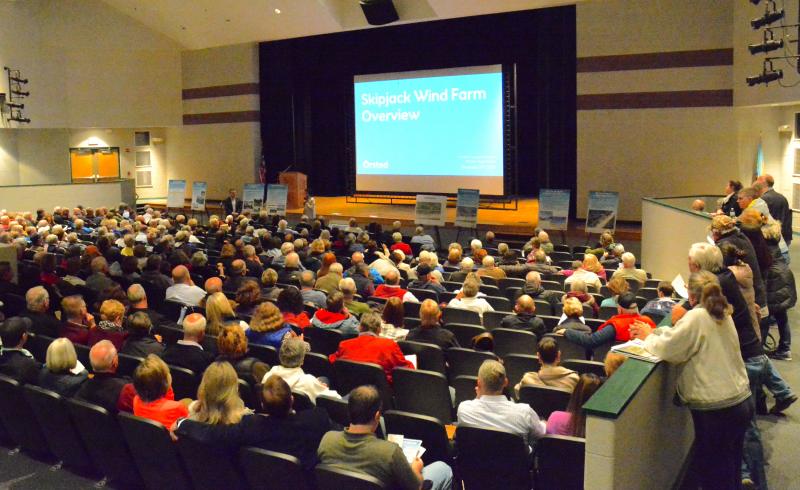Hundreds question Fenwick Island wind power connection
Lack of transparency, loss of natural environment and a general disdain that Maryland officials approved a controversial wind farm off the coast of Delaware topped the concerns cited by the public during a meeting about a proposed transmission connection in Fenwick Island State Park.
During an October public meeting in Fenwick Island, officials from Delaware Department of Natural Resources and Environmental Control revealed plans for a transmission connection in Fenwick Island State Park for Skipjack Wind Farm. In return for being allowed to a facility to connect its wind power to the grid, Ørsted, the Danish company that would build the proposed wind farm, has offered to fund $18 million in improvements to the state park.
Due to public outcry, Senate Minority Leader Sen. Gerald Hocker, R-Ocean View, and Rep. Ronald Gray, R-Selbyville, hosted a public meeting Nov. 19 at Indian River High School auditorium in Dagsboro.
Ørsted and DNREC officials were on hand to answer questions. Looking out over an almost standing-room-only crowd, DNREC Secretary Shawn Garvin said, “Based on the turnout, we could have done a better job.”
Representing Ørsted were Joy Weber and Matt Drew. Weber said there are three simple reasons for the federal government’s interest in offshore wind power off the Atltantic coast – the dense population of the East Coast creates a huge demand, the offshore winds from Virginia to Maine are a good resource and the extended continental shelf allows the turbines to be anchored to the seafloor.
Longtime Fenwick property owner Janet Dudley-Eshbach was the first person to speak, and she garnered an auditorium of applause when she called the transmission connection project irresponsible and questioned developing one of the last undeveloped stretches of land remaining in Delaware.
“This is not Coney Island and we do not need pickleball courts,” she said. Pickleball courts on top of the acre-sized transmission connection are one of the improvements Ørsted has suggested.
Some members of the public spoke about a lack of transparency, citing a memorandum of understanding signed by Garvin and Ørsted in July that has only recently come to light.
The first word on the document is confidential, but Garvin responded each time by saying the document was not confidential and was not a binding agreement with Ørsted.
Some people wanted to know why Ørsted hadn’t completed an economic or environmental study yet.
Weber said the studies will be done as part of the final construction approvals.
Other people asked about the electromagnetic fields generated by transmission lines, including children playing near them and fish not wanting to cross the lines.
Holding her hands in a circle about the size of her face to demonstrate the size of the line, Weber said she understood there was a lot of concern about electromagnetic fields, but she said the lines will be buried 30 feet into the seafloor and the energy coming off the lines is well below federal tranmission standards.
Ocean City, Md. Mayor Rick Meehan said the city is not opposed to the wind farm proposed off its shores, but officials want it moved farther east so the turbines aren’t visible. The unobstructed view is one of the few things that remains undeveloped in Ocean City, he said, and that view would be changed forever.
The crowd several times became unruly when it didn’t like answers given by the people in the front of the room.
During a response by Weber to a question related to Ørsted investing hundreds of millions of dollars into Maryland, former Sussex County Councilman Rob Arlett yelled out from the back of the auditorium, “The energy is going to Maryland.”
Weber responded that investments were going to Maryland because Maryland awarded Ørsted the contract, Ørsted hoped to make investments in Delaware, and the power distribution is controlled by regional transmission organization PJM and would be distributed throughout the power grid.
While a significant majority of people who spoke were against the proposed transmission connection, a handful of people spoke in favor, saying something needs to be done for the environment and future generations.
One of the last comments of the evening was by Millsboro resident Tom Brett. Looking around the room, he said he was disappointed the average age of the attendees was older than 55. The wind farms aren’t being designed for people this age, he said. They’re being designed for future generations, he said.
Another woman in favor of the proposals said flooding of land along Delaware’s coastline is a problem, but if nothing was done to curb it, it would only get worse.
“In 20 years, there may not be a Fenwick Island,” she said. “We need to do something.”
DNREC is soliciting public comment on the proposed Fenwick Island State Park proposal until Monday, Dec. 2. Comments can be made at www.destateparks.com/fenwickimprovements.
At the time of the meeting, State Parks Director Ray Bivens said over 1,000 comments had been received on the subject.
Chris Flood has been working for the Cape Gazette since early 2014. He currently covers Rehoboth Beach and Henlopen Acres, but has also covered Dewey Beach and the state government. He covers environmental stories, business stories and random stories on subjects he finds interesting, and he also writes a column called Choppin’ Wood that runs every other week. He’s a graduate of the University of Maine and the Landing School of Boat Building & Design.




















































